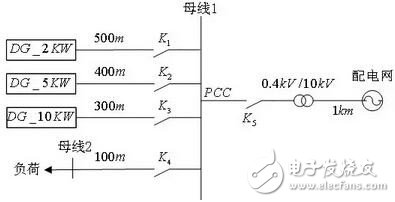Researchers Liu Bin, Lu Xiongwei, Xiong Yong, etc., from the School of Information Engineering, Nanchang Aviation University, Kehua Hengsheng Co., Ltd., and the School of Physics and Electronic Engineering, Qinzhou University, wrote an article in the 21st issue of the Journal of Electrical Engineering, 2015. In the wireless parallel system of inverters of the same power class, since the sharing of the system load may cause the small-capacity inverter to be inoperable, the load must be distributed in a manner proportional to the capacity of the inverter module.
Based on the droop control principle, the sufficient conditions for the distribution of the inverter load according to the capacity are derived by analyzing the convergence of the output voltage amplitude and frequency. This sufficient condition has a good guiding effect on the determination of the droop control coefficient. In addition, by introducing a virtual impedance method and a dual-loop regulator, a microgrid system consisting of two inverters of different capacities was built. Finally, the effectiveness of the theoretical analysis is verified by simulation and experiment.
On the one hand, with the development of the national economy, the demand for electricity is also growing rapidly, but blindly expanding the scale of the power grid cannot meet the requirements of power supply. On the other hand, several large blackouts in the 1960s triggered researchers to pay attention to the potential benefits of distributed generation systems. Although the distributed power supply has outstanding advantages, it is an uncontrollable source relative to the power grid, and the microgrid has emerged in this environment.
From a system perspective, it considers distributed power, load, energy storage devices and control devices as a single controllable unit that can be networked with the grid or with the main grid when the system fails or the system needs to be disconnected. The network disconnects to run separately. This flexible schedulability of the microgrid makes it a powerful complement and effective support for large-scale power grids in the future. For this reason, research on microgrids in recent years has attracted wide attention from the social and academic circles.
Among the microgrid control strategies, there are three most common ones. That is, PQ control is adopted during grid-connected operation, and V/f control or droop control is adopted during island operation. Because this paper focuses on the load distribution problem of micro-grid island operation, the capacity of the main control power supply is higher based on the single V/f micro-power master-slave control mode, and the overall micro-grid dependence on the main power supply is too high. Finally, the micro power supply peer-to-peer control method based on droop control is selected as the control strategy of load distribution in this paper.
In addition, depending on whether there is an interconnection between the inverters, the inverter parallel technology can be divided into two categories: interconnected parallel and non-interconnected parallel. The former limits the interconnection between inverter modules due to the existence of interconnected wires. The distance, compared to the interconnected line parallel technology has a better development prospects. Among them, the key to realize the parallel connection technology [7-8] is to adjust the load allocated by the system to each inverter module according to the droop characteristic between the output voltage amplitude and the frequency and the output power.
Most domestic research on parallel connection technology without interconnects is focused on inverters of the same power class. This traditional parallel technology requires the system to achieve power sharing. For wireless parallel technology of inverters of the same power class, since the sharing of system load may cause the small-capacity inverter to be inoperable, it is necessary to distribute the load in a manner proportional to the capacity of the inverter module. A hot spot in microgrid research in the past two years. There are not many relevant conclusions in foreign countries, and there are fewer domestic ones, which are far from perfect.
This article is based on the introduction of microgrid structure and droop control principles. Firstly, the critical conditions of the system stability are derived by analyzing the convergence of the output voltage amplitude and frequency. Then, in the system controller design, the virtual impedance method and the double loop regulator are introduced. For the problem of voltage distortion caused by rectifying nonlinear load, this paper uses quasi-resonant regulator for harmonic compensation.
Finally, in order to verify the correctness of the above conclusions and strategies, this paper uses Matlab/Simulink to simulate and build an experimental platform composed of two inverters with different capacities. The experimental results show that the target of distributing load according to inverter capacity can be better achieved by adjusting the droop coefficient and the virtual impedance.

Figure 1 Microgrid structure
in conclusion
In this paper, the problem of capacity distribution load of inverter parallel system is discussed around the principle of power droop control. First, the critical conditions for system stability are derived by analyzing the convergence of the output voltage amplitude and frequency. Then the virtual impedance loop and the double loop regulator are introduced to construct a simulation platform of the microgrid system. The theoretical analysis is verified. From the comparison of the four sets of waveforms in Figure 7, the condition of the convergence of the amplitude of a single distributed power supply is the active droop coefficient. Less than the critical value, the condition of a single distributed power supply voltage frequency convergence is that the reactive power droop coefficient is less than the critical value.
In addition, for the problem of output voltage distortion caused by rectified nonlinear load, the quasi-resonant regulator is used for harmonic compensation. The two sets of simulation waveforms in Figure 8 can explain the compensation effect. The final experimental platform also verified the simulation results.
ZGAR GenkiIppai Pods 5.0
ZGAR electronic cigarette uses high-tech R&D, food grade disposable pod device and high-quality raw material. All package designs are Original IP. Our designer team is from Hong Kong. We have very high requirements for product quality, flavors taste and packaging design. The E-liquid is imported, materials are food grade, and assembly plant is medical-grade dust-free workshops.
From production to packaging, the whole system of tracking, efficient and orderly process, achieving daily efficient output. WEIKA pays attention to the details of each process control. The first class dust-free production workshop has passed the GMP food and drug production standard certification, ensuring quality and safety. We choose the products with a traceability system, which can not only effectively track and trace all kinds of data, but also ensure good product quality.
We offer best price, high quality Pods, Pods Touch Screen, Empty Pod System, Pod Vape, Disposable Pod device, E-cigar, Vape Pods to all over the world.
Much Better Vaping Experience!


ZGAR GenkiIppai 5.0 Pods,ZGAR GenkiIppai Pods 5.0,ZGAR GenkiIppai Pods 5.0 Pod System Vape,ZGAR GenkiIppai Pods 5.0 Disposable Pod Vape Systems, Japanese culture style
ZGAR INTERNATIONAL(HK)CO., LIMITED , https://www.zgarecigarette.com